Abstract
Construction materials have a direct impact on the environment, on people, and their health. In addition, building insulation plays a decisive role in terms of energy consumption of buildings and regarding CO2-emissions over their whole life cycle. In order to achieve a holistic concept for green building worldwide, it is necessary to develop ecological insulating materials and to scientifically examine them in terms of their technical properties, as done with particleboards from agricultural waste presented in this article. This study aims to characterize the properties’ tensile and compressive strength, modulus of rupture (MOR), and elasticity (MOE) and thermal conductivity of particleboards affected by parameters, such as waste type (rice straw or flax shives), particleboard density, resin type, and content, as well as the use of treated rice straw. Particleboards made from flax shives had superior properties compared to the rice straw particles. The mechanical properties of the boards increase with an increasing resin content, except for the MOR and MOE, which decrease with an increasing resin content, and reach their peak value at a resin content of 10%.
1. Introduction
Energy demand and costs for heating during winter and cooling during summer are very high. Building insulation can reduce these expenses, which is why its use is becoming more and more important. Due to the increased use, the production of suitable materials is just as important. Insulation materials are usually produced from inorganic materials, even though some of those materials have been prohibited due to the suspicion of health risks in the past. Furthermore, these materials do have a high impact on the environment. This is why it is important to investigate insulation materials based on organic materials.
In addition to that, large quantities of agricultural residues are available. Those residues from agricultural production have a high potential to be used as alternative for some inorganic materials, such as particleboards. With regard to the regional availability of the materials and the resulting ecological footprint, numerous studies on organic based insulation materials have already been carried out by researchers with materials such as sheep wool, straw, cotton, and flax for Austria and the Czech Republic [1,2,3]. Rice is the primary food for more than 40% of the world’s population. Every year, 596 million tons of rice are produced, resulting in 570 million tons of rice straw worldwide [4,5]. Currently, 12 million MTs of rice straw are produced yearly in Egypt [6]. This quantity is the reason why rice production has a high impact in Egypt and this rice straw, as a residue of this production, poses a serious problem for the farmers involved. Rice straw is conventionally cleaned, burned, or used for temporary heating purposes. This current practice causes serious environmental problems. But rice straw is a renewable resource that can be used as raw material for the production of insulated particleboard. A particleboard is a sheet product manufactured under pressure from particles of wood or other lignocellulose materials by adhesive [6]. With the increasing demand for particleboards, the demand to provide alternatives with renewable and ecological materials is accordingly growing. This research will use rice straw as alternative to fill this gap.
The principal chemical composition of rice straw is 28–48% cellulose, 12–16% lignin, 15–20% ash, and 9–14 silica. The fiber length is between 0.4–3.4 mm with an average value of 1.4 mm, and the fiber width is from 4–16 mm, with an average value of 8 mm [7].
Tong et al. [8] found that straw shows numerous positive properties, such as low density and a renewable nature. Rice straw is an annually renewable agricultural waste. Particleboard performance depends on the properties of adhesives and their compatibility with fibres. Several kinds of adhesive resins have been used to fabricate strawboards. For wood-based particleboards, urea-formaldehyde (UF) has been the essential adhesive. Also, for the production of particleboards from eggplant stalks, UF is technically viable as an adhesive [9]. Junjun et al. [10] investigated the influence of varieties of starch (cornstarch, cassava starch, potato starch) on flexural properties of composites. According to [10], composites based on cornstarch had higher flexural strength and flexural elastic modulus.
Particleboards and their properties have already been researched in numerous previous investigations, in which the improvement of the mechanical properties through modification of resin content, particleboard density, and straw treatment could be identified. The mechanical properties of particleboards made of mesquite, salt cedar, and date palm, for example, were improved as the UF resin content increased from 9 to 11% [11]. In [12], the qualities of the particleboard improved when the content of UF resin increased from 7% to 16%. The mechanical properties of the saline Jose tall wheatgrass (JTW) particleboards improved with the increase of particleboard density from 0.71 to 0.75 g/cm3 [13]. Values of the mechanical parameters showed that hot-water treatments on rice straw induced better performance on the obtained composites [14]. Steam and short durations of OA-treatment resulted in significantly improved mechanical properties of UF-bonded rice straw particleboards [15]. A positive effect on the mechanical properties of the board can also be reached through the treatment of oil palm particles, as well as an improvement of the board properties by a treatment with hot water [16]. The positive effects of a pre-treatment with the white-rot fungus T. hirsute on the mechanical properties of a corn-stalk-based fiberboard were investigated and analyzed by [17]. While [18,19] focused their work on particle size and the binderless pressing process, this study examines not only mechanical properties but also thermal conductivity as a function of different densities, pre-treatments, and adhesives. The main focus is on the investigation of rice straw, whose achieved properties, however, are always compared with those of flax shives.
So far, only a little information is available on the use of rice straw for particleboard in combination with adhesives and effect of resin content, particleboard density, and rice straw treatment on the mechanical properties of particleboard. To achieve more knowledge about these interrelations, the specific objectives of this work are to utilize rice straw for making insulation particleboards and evaluate the effect of different waste type, resin type, resin content, particleboard density, and rice straw treatment on the mechanical properties of particleboard.
2. Experimental Procedures
2.1. Material Tests
Rice straw cultivated on the Shubra Millis, Zifta, Al Gharbiyah Governorate, Egypt, served as material sample. At maturity, the straw was harvested and left in the open field for two weeks to dry. The moisture content (MC) of the straw was about 5%. The commercial UF resin adhesive (65 wt % of solid content) was used as a composite binder (El-Nasr Company for Intermediate Chemicals, Giza, Egypt). Ammonium chloride (NH4Cl) (El-Nasr Company for Intermediate Chemicals, Giza, Egypt) solution (10 wt %) was added to the UF as a hardener material. These two materials and flax shives were obtained from Tanta Company of Flax and Oils Tanta. The flax shives particle size ranged between 1 mm to 5 mm. Food grade corn starch was used as an adhesive material and manufactured by Tag ElMelouk Food Industries, 6th of October City, Egypt.
2.2. Sample Preparation
The process of sample preparation is shown in Figure 1 and Figure 2 and is described in the following paragraph.
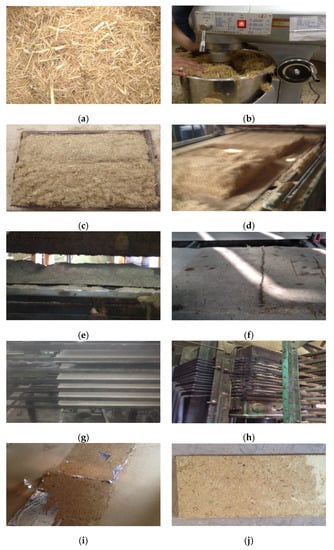
Figure 1.
Sample manufacturing processes: (a) Mild rice straw, (b) Mixing straw with resin material, (c) Straw mix with resin material in mold, (d) Straw mold before primary press, (e) Straw mold put in platens before primary press, (f) Straw mold after the primary press, (g) Particleboard before hot press, (h) Particleboard between heated platens of the press, (i) Particleboard after the hot press, and (j) Particleboard after trimming.

Figure 2.
Flow chart of particleboard manufacturing process.
Rice straw was collected from local farming operation and crushed with by a hammer mill into different particle sizes of 10–40 mm. After this, the straw particles were screened to eliminate fine particles and dust from the straws.
The treatment of rice straw was made according to [10] and the preparation of starch was based on [14]. A desired amount of straw was sprayed with resin material and afterwards was sufficiently mixed for 8 min. The mixture was then filled into a steel mold of 700 × 350 mm and placed on a wooden board. After filling the first layer, the straw was manually compacted to ensure that the mold was properly filled. The steel mold was then removed, and the first pressing was carried out. This was done with a manually controlled hydraulic press and took about 2 min. After this primary press, the samples were placed between the heated platens of the hot press, which were heated to a constant temperature of 180 °C and applied the pressure of a 210 bar to ensure optimal curing of the resin material. It took 4 min to reach constant temperature and 8 min until the hot-pressing process was completed. After adjusting the edges of the samples with a utility knife, the finished boards were cut to desired length, width, and to square the edges.
Various recipes of particleboards with different parameters were prepared for testing and are shown in Table 1. The variated parameters include resin ratio (10%, 12%, and 14%), resin type (Urea formaldehyde (UF), and cornstarch (CS)), waste type (rice straw and flax shives), particleboard density (0.3, 0.5, and 0.7 g/cm3), and straw treatment (hot water and sodium hydroxide (NaOH)).

Table 1.
Designed particleboard recipes.
2.3. Test Procedure
The board samples were cut into various specifications according to the ASTM standard method D1037-06 [20]. To achieve stable testing conditions for the conducted analyses, the samples were conditioned for 72 h in a Fisher-brand Desiccators Cabinet, maintained at 65% RH and 20 ± 1 °C.
2.3.1. Flexural Strength (Static Bending)
Static bending tests were conducted to determine the flexural properties, such as modulus of rupture (MOR) and apparent modulus of elasticity (MOE). Static bending tests were conducted on samples in accordance with ASTM D1037-06 Section 9 [20]. To obtain MOE and MOR for the particleboards, a three-point bending test was conducted (Figure 3). The flexural strength was measured by using rectangular specimens with dimension of 530 × 76 × 20 mm. Each flexural strength result was the average of strength for three specimens as replicates. According to ASTM D1037, each sample was loaded with a central loading nose, as well as two support noses with a radius of 25.4 mm each and a span of 24 times the nominal board thickness between them. The test specimens were loaded by lowering the central nose at a constant crosshead rate, which is determined by the geometry of the test specimen from (1).
where:
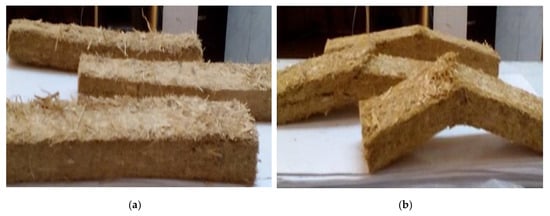
Figure 3.
Samples for static bending test—(a) before the test, (b) after the test.
- N: Rate of motion of moving head, in./min (mm/min),
- z: Unit rate of fiber strain, in./in. (mm/mm) of outer fiber length per minute (= 0.005),
- L: Span, in. (mm), and
- d: Depth (thickness) of specimen, in. (mm).
To calculate MOE and MOR for the samples according to (2) and (3), the maximum load reached during the test and the equivalent vertical deflection were recorded.
where:
- : Modulus of rupture, MPa.
- : Maximum load, N.
- : Width of specimen, mm.
- : Modulus of elasticity, MPa.
- Slope of the straight line portion of the load deflection curve, N/mm (slope between 10% of Pmax and 40% of Pmax as suggested in note 16 of ASTM D1037).
2.3.2. Internal Bond Strength (Tension Perpendicular to Surface)
Tension tests were made to determine the cohesion of the panel in the direction perpendicular to the plane of the panel. The internal bond was measured according to ASTM D1037-06 Section 11 [20]. The internal bond strength was measured by using square specimens with dimensions of 50 × 50 × 20 mm. The average of strength was evaluated for three specimens as replicates. The samples were prepared by attaching the test specimens to aluminium load blocks. This was done by first heating the load blocks and then melting an adhesive to its surface. The individual samples were then placed between two loading blocks and the adhesive was applied at room temperature without pressure. Then, 24 h after this adhesive process, the tests were carried out on the specimens. The test specimens were loaded by clamping the loading blocks to the slot in order to ensure sufficient contact with the fixture arms (Figure 4). The loading of the samples was carried out perpendicular to the panel face until specimen failure occurred. ASTM D1037 specifies a loading speed of 0.08 cm/cm of thickness per min. In this investigation, the test samples were loaded with a speed of 1.6 mm/min.
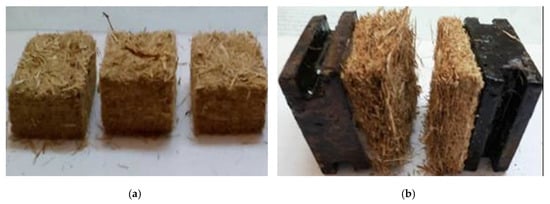
Figure 4.
Samples for tension test—(a) before the test, (b) after the test.
In order to calculate the internal bond according to (4), the maximum load achieved during the test before specimen failure was recorded.
where:
: Internal bond strength, MPa.
2.3.3. Compression Strength
The compression test was done to determine the compressive strength in the plane of the panel (Figure 5). Compression was measured according to ASTM D1037-06 Section 12 [20]. The specimens’ dimensions were 102 × 25 × 20 mm (rectangular pieces). Three samples were used for the test as replicates. The specimen was centred carefully through a spherical loading block in the testing machine in a vertical plane for unsupported (102 mm) specimen. The specimen was loaded parallel to the panel face until failure occurred. Other than what was suggested in ASTM D1037, the load speed was constant at 0.5 mm/min instead of 0.005 mm/min. The maximum load realized during the test before specimen failure occurred was recorded and used to calculate the compression strength, as shown in (5).
where:
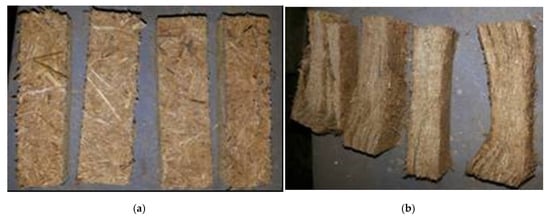
Figure 5.
Compressive strength test samples—(a) before the test, (b) after the test.
- : Compressive strength, MPa.
2.3.4. Thermal Conductivity
Thermal conductivity was measured for three samples as replicates for each recipe. The specimens’ dimensions were 300 × 300 × 20 mm (square pieces).Thermal conductivity was measured according to ASTM C 518-85 [21]. The relation is expressed in (6).
where:
- : Thermal conductivity, W/m K.
- : Heat flux flowing through the sample, W/m2.
- : Thickness of sample, m.
- : The difference in temperature between the hot and cold surfaces of specimen, K
In order to carry out the determination of the thermal conductivity according to standards, it is necessary to stabilize a uniform one-dimensional temperature field. In this field, the specimen is clamped between two flat isothermal plates at two different temperatures. In addition, the temperature field within the specimen must be uniform and the plates of the measuring instrument should be larger than the specimen. The temperature gradient is calculated as the difference between temperatures on the hot and cold plates ( − ) and sample thickness ΔX, as average temperature gradient dT/dX is equivalent to ΔT/ΔX. Figure 6 shows the schematic of the thermal conductivity test device. The same procedure was also conducted already in [22,23] for earth bricks and earth plaster from agricultural waste.
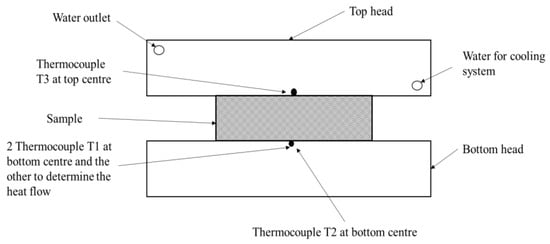
Figure 6.
Schematic of thermal conductivity test.
3. Results and Discussion
In the following, the results of the respective investigations carried out with different types of waste, particleboard density, resin type, as well as varied content and treatment of the straw, are demonstrated. Within these variants, the flexural strength, the internal bond strength, and the compression strength, as well as the thermal conductivity, were investigated. In the end, Table 2, Table 3 and Table 4 give an overview of the overall results in relation to the material parameters examined, which are presented in the following paragraphs in more detail.

Table 2.
Bending properties of particleboard.

Table 3.
Internal bond property of particleboard.

Table 4.
Compression strength of particleboard as affected by various variables.
3.1. Effects of Waste Type
3.1.1. Flexural Strength (Static Bending)
Figure 7 illustrates MOR and MOE as a function of waste type. Comparing the MOR and MOE for flax shives with values of 13.85 MPa and 1722 MPa and the values for rice straw of 1 MPa and 181.9 MPa, it can be seen that the that boards made from flax shives exhibited superior bending properties compared to rice straw. This may be due to use of small particles (1–5 mm) that improve the bending properties of the particleboard due to high compaction ratio. These results trend agreed with those achieved by [24].
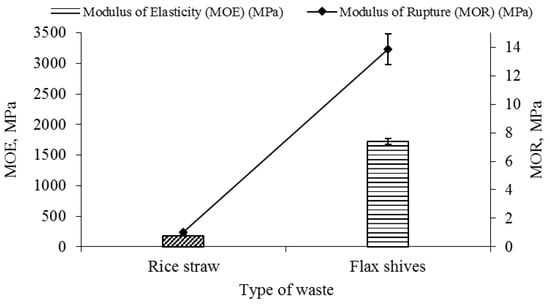
Figure 7.
The effect of waste type on bending properties of the particleboard.
3.1.2. Internal Bond Strength
The results shown in Figure 8a demonstrate the influence of waste type on the internal bond property of the experimental rice straw particleboard. Concerning bending properties such as MOR and MOE, boards made from flax shives showed a higher internal bond than those made from rice straw particles, as shown in Figure 9. The internal bond value increased from 0.02 to 0.6 MPa. One reason for this may be the higher compaction of the flax fibers. This results in a faster heat transport, which in turn contributes to a resin curing. These results trend agreed with those achieved by [24].
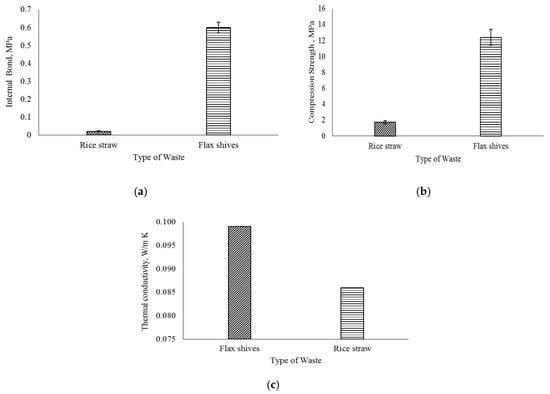
Figure 8.
(a) Internal bond of particleboard as a function of waste type, (b) Influence of waste type on compression strength of particleboard, and (c) Thermal conductivity of particleboard made from rice straw and flax shives.
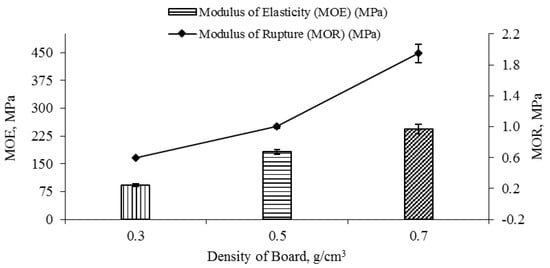
Figure 9.
The effect of board density on bending properties of particleboard.
3.1.3. Compressive Strength
The board made from rice straw particles is much weaker in compressive strength than that made from flax shives, as shown in Figure 8b. The compressive strength value increases from 1.7 to 12.4 MPa. This is because the flax particles were smaller than rice straw particles. Therefore, the compaction of the flax shive particleboard increases. The mechanical split of flax shives results in a better compression strength of composites compared to rice straw. A possible reason for this may be the increased surface area of flax shives compared with rice straw. The same results were obtained by [25], who concluded that the mechanically split wheat straw and polypropylene-based composites had higher mechanical properties compared with whole wheat straw and polypropylene-based composites.
3.1.4. Thermal Conductivity
The thermal conductivity of particleboard with two waste types is shown in Figure 8c. The obtained results revealed that the board made from flax shives particles had higher thermal conductivity (0.099 W/m K) compared to the rice straw particles (0.086 W/m K). The lower thermal conductivity of the rice straw particle is mainly due to the presence of non-polar groups and the higher SiO2 content of straw, which reduces the connection between particles [10]. New insulating particleboards are manufactured using rice straw with UF resin as a binder for its fibers.
3.2. Effects of Particleboard Density
3.2.1. Flexural Strength (Static Bending)
The bending properties of the boards depend on the density. Figure 9 shows this dependence in the form of the resulting MOR and MOE. Increased density leads to improvement of the bending properties. The higher the density of the particleboard, the higher the resulting number of contact points causing an inter-bonding between fibers, which consequently improves the bending strength. The particleboard with a lower density reached a MOR value of about 0.6 MPa, the corresponding MOE value was 91.8 MPa. A higher density in the produced particleboard improved the bending properties, causing MOR to increase to 1.95 MPa and the corresponding MOE value to reach approximately 244 MPa. These results trend are similar to those obtained by [13,26] where they found that increasing the particleboard density from 0.71 to 0.75 g/cm3 improved the MOR and MOE properties of the saline Jose Tall Wheatgrass particleboards made with 4% polymeric methane diphenyl diisocyanate (PMDI).
3.2.2. Internal Bond Strength
The presented results in Figure 10a demonstrate the effect of the board density on the internal bond property of the rice straw particleboard. The internal bond strength first increased and then decreased with increasing the particleboard density from 0.3–0.7 g/m3. When the density increased from 0.3–0.5 g/m3, the internal bond increased significantly from 0.003 to 0.020 MPa. On contrast, it decreased slightly from 0.020 to 0.008 MPa when the density increased from 0.5–0.7 g/m3. This can be explained by the looser inner structure and a lower adhesive performance at low density. For a density of about 0.5 g/cm3, the adhesive material was evenly distributed and effective, and could glue the rice straw completely. Hence, the internal bond strength reached the peak value. At a density higher than 0.5 g/cm3 the internal structure is more compact, which causes a more difficult distribution of the adhesive material. These outcomes are similar to the results obtained by [10], where they reported that the flexural properties of cornstarch-based composites increased significantly with increasing of the density from 0.6–0.7 g/cm3 and decreased slightly at density higher than 0.7 g/cm3.
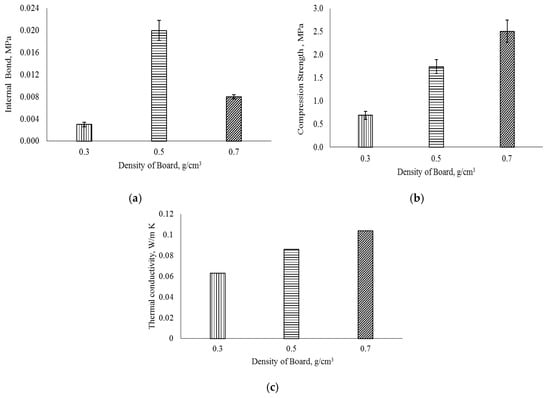
Figure 10.
(a) Internal bond of particleboard as a function of board density, (b) The effect of board density on compression strength of particleboard, and (c) Thermal conductivity of particleboard as a function of board density.
3.2.3. Compression Strength
Figure 10b plots the effect of board density on the compression strength of rice straw particleboards. Increasing of the density of particleboard positively affects the compression property: compression strength increased with increasing of particleboard density. The high density of the particleboard showed high compressive strength due to their low porosity. It appears that the compression strength increased from 0.7 to 1.7 MPa with increasing the board’s density from 0.3 to 0.5 g/cm3. The peak value of compressive strength reached 2.5 MPa at particleboard density of 0.7 g/cm3. These results agreed with those obtained by [27]. They found that the compression strength of low-density particleboard made from wheat straw and corn stalk pith increased from 3.01 MPa to 4.29 MPa, when the density increased from 0.30 to 0.34 g/cm3.
3.2.4. Thermal Conductivity
The board density affects the thermal conductivity of the particleboard, as shown in Figure 10c. The conducted tests showed that at a board density of 0.3 to 0.7 g/m3, the thermal conductivity increased from 0.063 to 0.104 W/m K, respectively. It can be stated that with increasing density, the proportion of solid components in the particleboard increases as well, as does the thermal conductivity. Also, Lertsutthiwong et al. [28] concluded that the thermal conductivity of the particleboards made from solid wastes from tissue paper manufacturing and corn peel decreased with increasing the amount of added corn peel in the mixture, which decreased the density of the produced particleboard.
3.3. Effects of Resin Type
3.3.1. Flexural (Static Bending)
Figure 11 illustrates the MOR and MOE as a function of the adhesive type. The bending properties of the particleboard strongly depend on the type of adhesive used. In general, it can be seen that the utilization of adhesive materials resulted in significant improvement of the particleboard’s bending properties. The particleboards blended with urea formaldehyde generate a higher number of contact points so that an inter-bonding between fibers results. This improves the bending strength of the board. For particleboards blended with cornstarch and binder less particleboards, the MOR values reached were about 0.3 and 0.46 MPa, respectively, and the corresponding MOE values reached 5.73 and 23.1 MPa. The produced particleboard blended with urea formaldehyde lead to improve the bending properties, so that MOR increases to 1 MPa and the corresponding MOE value reached approximately 181.9 MPa.
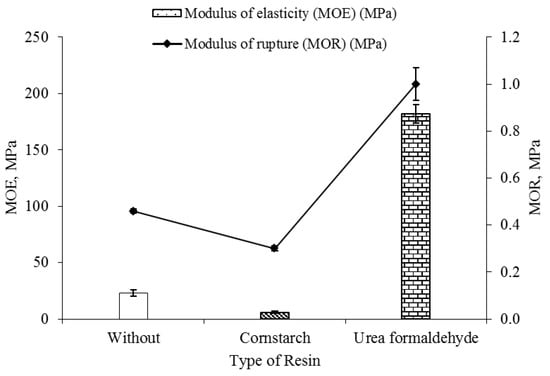
Figure 11.
The influence of resin type on bending properties of particleboard.
3.3.2. Internal Bond Strength
The results reveal that the influence of the resin type on internal bond strength is essential. As shown in Figure 12a, rice straw particleboards with cornstarch resin with a content of 10% as adhesive, as well as particleboards without any resin, showed much poorer internal bond properties than particleboards bonded using UF resin with a content of 12%. With the use of urea formaldehyde resin, the internal bond significantly increased from 0.003 to 0.02 MPa. Contrarily, with the use of cornstarch resin, the internal bond slightly decreased from 0.003 to 0.002 MPa.
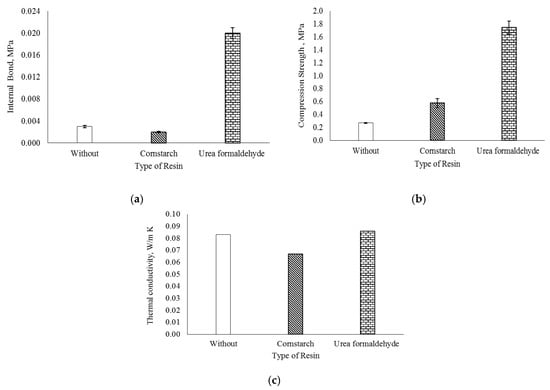
Figure 12.
(a) Internal bond of particleboard as a function of resin type, (b) The effect of resin type on compression strength of particleboard, and (c) Thermal conductivity of particleboard as a function of resin type.
3.3.3. Compression Strength
It can be seen from Figure 12b that the adhesive type significantly affected the compression strength. Particleboard bonded with adhesive material had better compression strength than those made without adhesive material, where compression strength increased from 0.27 to 0.58 MPa. The particleboard made with urea formaldehyde had higher compression strength than the one made with cornstarch adhesive, where compression strength increased from 0.58 to 1.74 MPa.
3.3.4. Thermal Conductivity
The thermal conductivity of the particleboard with three resin types are presented in Figure 12c. The results indicated that the particleboards blended with corn starch and binderless particleboards had superior thermal conductivity to that blended with urea formaldehyde. At constant density (0.5 g/cm3), the particleboard made from straw blended with corn starch had the lowest thermal conductivity (0.067 W/m K) as compared with other resin materials. For particleboards without resin material, the obtained thermal conductivity was 0.083 W/m K, while particleboard blended with urea formaldehyde had the highest thermal conductivity (0.086 W/m K). Particleboards without any added resin are completely made from waste materials and do not contain any chemical binders. They are therefore made out of an ecological material and can be equivalent conventional insulation materials [29]. Panyakaew and Fotios [29] stated that the binderless boards made from waste materials such as coconut husk and bagasse, and without any chemical binders, are environmental friendly and can possibly compete with conventional insulation materials.
3.4. Effects of Resin Content
3.4.1. Flexural (Static Bending)
Figure 13 presents the MOR and MOE as a function of the resin content. The bending properties of the boards were strongly dependent on the resin content. The results prove that a decreased resin content led to improving the bending properties. The lower resin content of the particleboards led to a higher number of contact points (inter-bonding between fibers), so that the bending strength was improved. For particleboard produced with a higher resin content (14%), the MOR value reached 1.3 MPa, and the MOE value was 213.6 MPa. Lower resin content (10%) in the produced particleboard led to improve bending properties, causing MOR to increase to 2.1 MPa and the MOE value to increase to around 344.97 MPa. The bending properties decreased with an increasing resin content; this was attributed to increase solidification of particleboard.
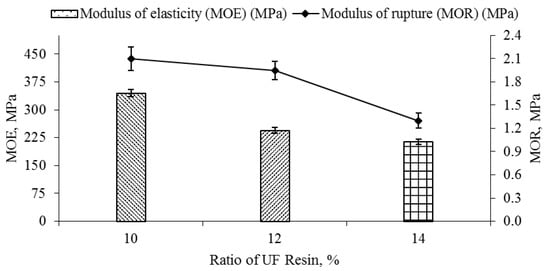
Figure 13.
Bending properties of particleboard as a function of resin ratio of urea formaldehyde.
3.4.2. Internal Bond Strength
Figure 14a shows a definitive relationship between the resin content of the produced particleboard and the internal bond property. While increasing of UF resin ratio in the produced particleboard led to a positive influence by improving the internal bond property of particleboard, increasing the resin content of the produced particleboard from 10% and 12% to 14% improved the internal bond significantly. The internal bond value of particleboards with lower resin content was 0.002 MPa, whereas that of boards produced with a higher resin content was 0.016 MPa. This results trend agreed with [9], who found out that the internal bond of the particleboards made from eggplant stalks increased with an increase in ratio of urea formaldehyde and melamine urea formaldehyde adhesives.
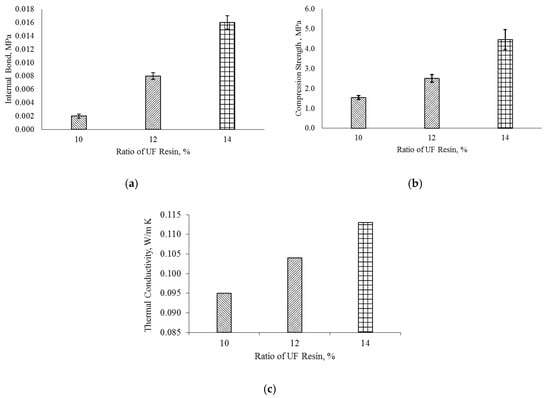
Figure 14.
(a) The influence of resin ratio of urea formaldehyde on internal bond of particleboard, (b) Compression strength of particleboard as a function of resin ratio of urea formaldehyde, and (c) The effect of resin ratio of urea formaldehyde on thermal conductivity of particleboard.
3.4.3. Compressive Strength
The compressive strength was plotted as a function of resin content for all produced particleboards in Figure 14b. The results proved that the effect of the resin content on compressive strength is very important. While increasing the UF content led to improved compressive strength of the produced particleboard, at a particleboard density of 0.7 g/cm3, increasing the resin content from 10% to 14% led to increasing the compressive strength from 1.55 to 4.46 MPa.
3.4.4. Thermal Conductivity
As expected, higher amounts of urea formaldehyde resin in the straw mixture resulted in a higher thermal conductivity at constant density (0.7 g/cm3), as shown in Figure 14c. Thermal conductivity was increased from 0.095 to 0.113 W/m K with increasing the resin content from 10 to 14%. Thermal conductivity of the boards blended with a resin ratio of 10% was 19% lower than boards blended with a resin ratio of 14%. In general, it can be concluded that the thermal conductivity of the boards was positive to its resin content.
3.5. Effects of Treated Straw
3.5.1. Flexural (Static Bending)
Figure 15 presents the bending properties modulus of rupture (MOR) and modulus of elasticity (MOE) as a function of the chemical treatment of straw. The bending properties of the boards strongly depend on the chemical treatments of straw. For board made from untreated straw, the MOR value reached 1 MPa, while the MOE value reached 181.9 MPa. Particleboard made from NaOH treated straw lead to improved bending properties, while MOR increased to 2.1 MPa and the MOE value to reach approximately 221 MPa, while particleboard from hot-water treated straw led to improved MOR, causing an increase to 2.8 MPa and worse MOE, causing a decrease to 163.6 MPa.
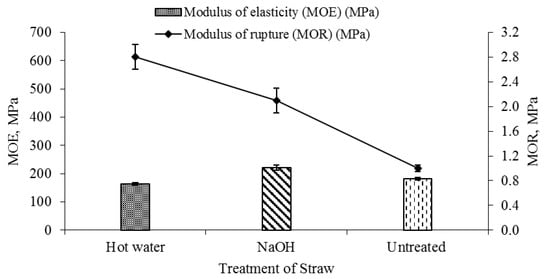
Figure 15.
The effect of treated rice straw on bending properties of particleboard.
3.5.2. Internal Bond Strength
Figure 16a shows the effect of treated straw on the internal bond strength of rice straw board made from 12% UF resin. In contrast, NaOH treatments on Rice Straw (RS) reduced IB of the particleboard slightly. It appears that for particleboard made from hot water-treated straw, the internal bond strength initially increases from 0.02 to 0.045 MPa and then decreases to 0.005 MPa when the straw treatment changes to NaOH treated straw. This could be due to the higher content of silica, this resisting the adsorption of rice straw with UF adhesive. Hot-water treatments on RS removed the silica and wax, which reduced the contact angle on straw surface and increased infiltration with UF adhesive, making a higher interface bonding strength between rice straw and adhesives. These results do not trend in agreement with those recommended by [14]. They illustrated that the hot water treated rice straw composites gave the best set of MOR, MOE, flexural strength, impact strength, and tensile strength, as NaOH treated rice straw composites yielded the best set of internal bonds.
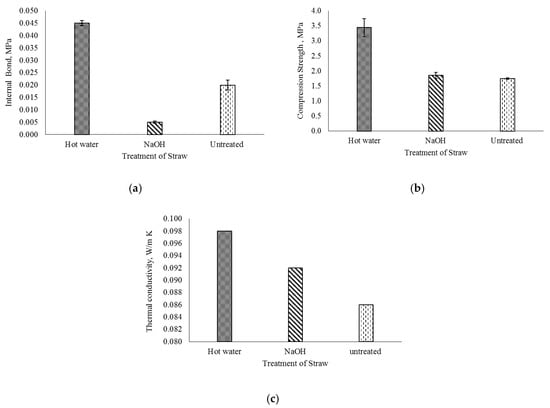
Figure 16.
(a) Internal bond of particleboard as a function of treated rice straw, (b) The effect of treated rice straw on compression strength of particleboard, and (c) Thermal conductivity of particleboard as a function of rice straw treatment.
3.5.3. Compression Strength
Figure 16b shows the influence of pre-treatment on the compression strength of rice straw particleboards. Comparing the untreated rice straw particleboard, a significant improvement was observed thanks to the treatment with hot water: The compression strength increased from 1.7 to 3.4 MPa. For rice straw particleboards that have been treated with NaOH, the compressive strength increased to 1.8 MPa. The higher compressive strength can mainly be attributed to the extraction of hemicelluloses, wax, and other non-polar extractives from the rice straw through the pre-treatment. This procedure improves the compatibility between rice straw and the UF resin. These results clearly indicate that the pre-treatment with NaOH in comparison to the treatment with hot water has a negative effect on the compression strength of the boards. The results proved that the decrease of the compressive strength of the particleboards treated with NaOH may be due to the lower pH-value of particles and residual of NaOH on the surface and in the interior of the rice straw particles. This can cause a pre-curing of the UF resin in NaOH treated particleboards. This phenomenon of hardening therefore also partly explains the reduction of compression strength in treatment with NaOH compared to treatment with hot water.
3.5.4. Thermal Conductivity
Boards made from chemically treated straw showed superior thermal conductivity compared to the ones made from untreated straw, as shown in Figure 16c. The minimum thermal conductivity of the particleboard was (0.086 W/m K) for untreated straw, while for hot water, treated straw was (0.098 W/m K). This may be attributed to the high SiO2 content of straw itself, and in addition to that the non-polar surface structure in the fiber formed by SiO2. On top of that, there is a wax layer on the surface of the straw, which reduces friction between the straw and increases the gaps. Hot water usages could decrease SiO2 and wax content of the straw effectively. This led to a better cementation between straw and adhesive, which results in a higher thermal conductivity for the particleboard from hot-water treated straw. These results agreed with those mentioned by [30]. They found out that the conductivity coefficient of the wheat straw after alkaline treatment increased obviously.
4. Conclusions
Adding values to agricultural residues is highlighted nowadays especially, using it for manufacturing particleboards for thermal insulation. Therefore, in this study, the possibility of using rice straw for manufacturing particleboards are investigated. Different rice straw treatments, particleboards density, types, and ratios of used resin were studied and compared with the corresponding values of flax shives particleboards. The results indicated that particleboards made from flax shives had superior mechanical properties compared to the rice straw particles. Whereas, the thermal insulation of rice straw particleboards was better than flax shives particleboards. For the resin type, rice straw particleboards blended with UF had better mechanical properties compared to the particleboards blended with cornstarch or those without resin material. In contrast, the thermal conductivity of particleboards blended by cornstarch was lower than that blended by UF and without a binder. Additionally, increasing the ratio of resin material improved the mechanical properties of the boards, except for the MOR and MOE, which decreased with increasing resin content, and reached the peak value at a resin content of 10%. The higher amounts of urea formaldehyde resin caused a higher thermal conductivity.
Referring to particleboards’ density, increasing the particleboard’s density significantly improved the mechanical properties of the particleboards, except for the IB, which was initially increased then decreased with an increasing density, and reached the peak value at a density of 0.5 g/cm3. The maximum mechanical strength was obtained at a density of 0.7 g/cm3 and a UF resin content of 14%. Despite the improvement of mechanical properties through the increased density of boards, it led to increasing the thermal conductivity, which indicates a lower insulation performance. Finally, the treatment of rice straw by hot water induced a better performance on the mechanical properties of produced particleboards, except for MOE, which reached the peak value with NaOH treatment. The thermal conductivity of particleboards manufactured by untreated rice straw was the lowest. The treatment of straw increases the thermal conductivity, which leads to lower thermal insulation efficiency. Using other agricultural residues such as rape straw, wheat straw, corn straw, and solid fraction of anaerobic digestate for insulation particleboards manufacturing and studying the effects of different ratios and types of natural resin materials on thermal and mechanical properties could be an interesting work in the future.
Author Contributions
Z.H.: Realization of experiments in the laboratory; T.A.: support of laboratory experiments developing the research idea, designing the work experiments, preparing the materials and writing the manuscript; M.K.: support of laboratory experiments on thermal conductivity and other measuring instruments and developing the research idea; A.B.: Data analysis and design of the work; S.A.: Data analysis and design of the work; J.H.: extension of the research idea; rewriting the manuscript, correcting English language and managing the manuscript; A.K.: head of team; support in sharpening the research idea, designing the experiments
Funding
This research received no external funding
Acknowledgments
The authors express their sincere thanks to Tanta Company of Flax and Oils, Tanta, Al Gharbiyah Governorate, Egypt for providing facilities during preparation of the specimens and the Egyptian Organization for Standardization and Quality (EOS), Cairo, Egypt for reducing costs of the tests. The authors acknowledge the Open Access Funding by TU Wien.
Conflicts of Interest
The authors declare no conflict of interest. The funders had no role in the design of the study; in the collection, analyses, or interpretation of data; in the writing of the manuscript, or in the decision to publish the results.
References
- Zach, J.; Hroudová, J.; Korjenic, A. Environmentally efficient thermal and acoustic insulation based on natural and waste fibers. J. Chem. Technol. Biotechnol. 2016, 91, 2156–2161. [Google Scholar] [CrossRef]
- Hroudová, J.; Korjenic, A.; Zach, J.; Mitterböck, M. Entwicklung eines Wärmedämmputzes mit Naturfasern und Untersuchung des Wärme-und Feuchteverhaltens. Bauphysik 2017, 39, 261–271. [Google Scholar] [CrossRef]
- Zach, J.; Korjenic, A.; Petránek, V.; Hroudová, J.; Bednar, T. Performance evaluation and research of alternative thermal insulations based on sheep wool. Energy Build. 2012, 49, 246–253. [Google Scholar] [CrossRef]
- Abdel-Mohdy, F.A.; Abdel-Halim, E.S.; Abu-Ayana, Y.M.; El-Sawy, S.M. Rice straw as a new resource for some beneficial uses. Carbohydr. Polym. 2009, 75, 44–51. [Google Scholar] [CrossRef]
- Central Agency for Public Mobilization and Statistics (CAPMAS), Agricultural Sector. Annual Bulletin for Statistics of the Waste and Recycling Rice Straw; Central Agency for Public Mobilization and Statistics (CAPMAS), Agricultural Sector: Cairo, Egypt, 2013.
- Jones, D.; Brischke, C. (Eds.) Performance of Bio-Based Building Materials; Elsevier Ltd.: Amsterdam, The Netherlands, 2017. [Google Scholar]
- Rowell, R.M.; Han, J.S.; Rowell, J.S. Natural Polymers and Agrofibers Composites Characterization and Factors Effecting Fiber Properties. Nat. Polym. Agrofibers Compos. 2000, 115–134. Available online: https://pdfs.semanticscholar.org/b1c2/bc3af9a233098586c031f76af027cfb4db51.pdf (accessed on 14 September 2019).
- Jin, T.; Yunhai, M.; Luquan, R. Naturally biological materials and their tribology: A review. Tribology 2001, 21, 315–320. [Google Scholar] [CrossRef]
- Guntekin, E.; Karakus, B. Feasibility of using eggplant (Solanum melongena) stalks in the production of experimental particleboard. Ind. Crop. Prod. 2008, 27, 354–358. [Google Scholar] [CrossRef]
- Junjun, L.; Chanjuan, J.; Chunxia, H. Flexural Properties of Rice Straw and Starch Composites. AASRI 2012, 3, 89–94. [Google Scholar]
- Ashori, A.; Nourbakhsh, A. Effect of press cycle time and resin content on physical and mechanical properties of particleboard panels made from the underutilized low-quality raw materials. Ind. Crop. Prod. 2008, 28, 225–230. [Google Scholar] [CrossRef]
- Pan, Z.; Zheng, Y.; Zhang, R.; Jenkins, B.M. Physical properties of thin particleboard made from saline eucalyptus. Ind. Crop. Prod. 2007, 26, 185–194. [Google Scholar] [CrossRef]
- Zheng, Y.; Pan, Z.; Zhang, R.; Jenkins, B.M.; Blunk, S. Particleboard quality characteristics of saline jose tall wheatgrass and chemical treatment effect. Bioresour. Technol. 2007, 98, 1304–1310. [Google Scholar] [CrossRef] [PubMed]
- Junjun, L.; Chuanhui, H. Biodegradable Composites from Rice Straw and Cornstarch Adhesives. Adv. J. Food Sci. Technol. 2013, 5, 41–45. [Google Scholar]
- Li, X.; Cai, Z.; Winandy, J.E.; Basta, A.H. Effect of oxalic acid and steam pretreatment on the primary properties of UF-bonded rice straw particleboards. Ind. Crops Prod. 2011, 33, 665–669. [Google Scholar] [CrossRef]
- Jumhuri, N.; Hashim, R.; Sulaiman, O.; Nadhari, W.N.A.W.; Salleh, K.M.; Khalid, I.; Saharudin, N.I.; Razali, M.Z. Effect of treated particles on the properties of particleboard made from oil palm trunk. Mater. Des. 2014, 64, 769–774. [Google Scholar] [CrossRef]
- Wu, J.; Zhang, X.; Wan, J.; Ma, F.; Tang, Y.; Zhang, X. Production of fiberboard using corn stalk pretreated with white-rot fungus Trametes hirsute by hot pressing without adhesive. Bioresour. Technol. 2011, 102, 11258–11261. [Google Scholar] [CrossRef] [PubMed]
- Li, X.; Cai, Z.; Winandy, J.E.; Basta, A.H. Selected properties of particleboard panels manufactured from rice straws of different geometries. Bioresour. Technol. 2010, 101, 4662–4666. [Google Scholar] [CrossRef] [PubMed]
- Ferrandez-Garcia, C.C.; Garcia-Ortuño, T.; Ferrandez-Garcia, M.T.; Ferrandez-Villena, M.; Ferrandez-Garcia, C.E. Fire-resistance, physical, and mechanical characterization of binderless rice straw particleboards. BioResources 2017, 12, 8539–8549. [Google Scholar]
- American Society of Testing and Materials. Standard Test Methods for Evaluating Properties of Wood-Base Fiber and Particle Panel Materials; D1037-06 Section 9, 11, 12; American Society of Testing and Materials: West Conshohocken, PA, USA, 2006. [Google Scholar]
- American Society for Testing and Materials. ASTM C 518-85 Standard Test Method for Steady-State Heat Flux Measurements and Thermal Transmission by Means of the Heat Flow Meter Apparatus; American Society for Testing and Materials: West Conshohocken, PA, USA, 1989. [Google Scholar]
- Ashour, T.; Korjenic, A.; Korjenic, S.; Wu, W. Thermal conductivity of unfired earth bricks reinforced by agricultural wastes with cement and gypsum. Energy Build. 2015, 104, 139–146. [Google Scholar] [CrossRef]
- Ashour, A.T.; Wieland, H.; Georg, H.; Bockisch, F.J.; Wu, W. The influence of natural reinforcement fibres on insulation values of earth plaster for straw bale buildings. Mater. Des. 2010, 31, 4676–4685. [Google Scholar] [CrossRef]
- Tabarsa, T.; Jahanshahi, S.; Ashori, A. Mechanical and physical properties of wheat straw boards bonded with a tannin modified phenol–formaldehyde adhesive. Compos. Part B Eng. 2011, 42, 176–180. [Google Scholar] [CrossRef]
- Zou, Y.; Huda, S.; Yang, Y. Lightweight composites from long wheat straw and polypropylene web. Bioresour. Technol. 2010, 101, 2026–2033. [Google Scholar] [CrossRef] [PubMed]
- Khristova, P.; Yossifov, N.; Gabir, S. Particle board from sunflower stalks: Preliminary trials. Bioresour. Technol. 1996, 58, 319–321. [Google Scholar] [CrossRef]
- Wang, D.; Sun, X.S. Low density particleboard from wheat straw and corn pith. Ind. Crop. Prod. 2002, 15, 43–50. [Google Scholar] [CrossRef]
- Lertsutthiwong, P.; Khunthon, S.; Siralertmukul, K.; Noomun, K.; Chandrkrachang, S. New insulating particleboards prepared from mixture of solid wastes from tissue paper manufacturing and corn peel. Bioresour. Technol. 2008, 99, 4841–4845. [Google Scholar] [CrossRef] [PubMed]
- Panyakaew, S.; Fotios, S. New thermal insulation boards made from coconut husk and bagasse. Energy Build. 2011, 43, 1732–1739. [Google Scholar] [CrossRef]
- Zhu, X.D.; Wang, F.H.; Liu, Y. Properties of Wheat-Straw Boards with Frw Based on Interface Treatment. Phys. Procedia 2012, 32, 430–443. [Google Scholar] [CrossRef]
© 2019 by the authors. Licensee MDPI, Basel, Switzerland. This article is an open access article distributed under the terms and conditions of the Creative Commons Attribution (CC BY) license (http://creativecommons.org/licenses/by/4.0/).